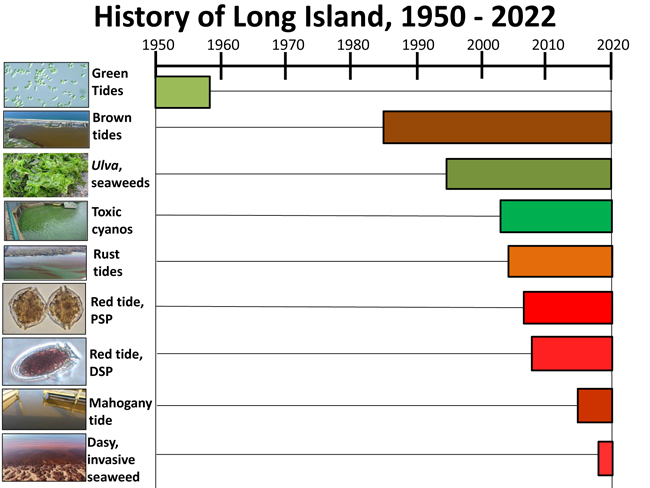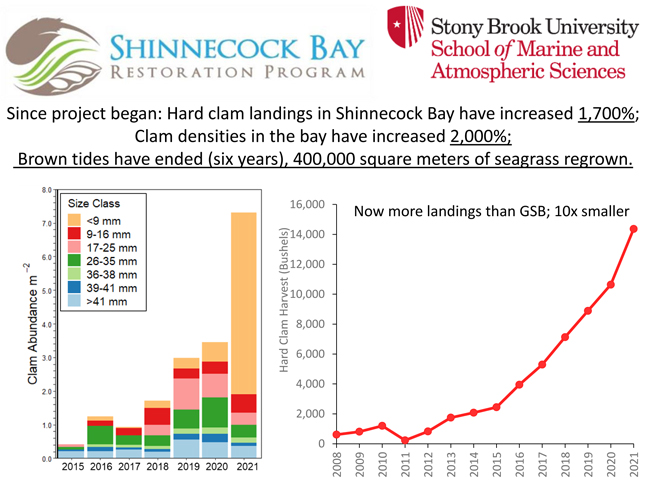Stony Brook, NY, September 14, 2022 - To understand some of the issues facing the region’s coastal communities, one scientist is asking us to think “Watershed of Destiny.” That was the subtitle of this year’s "State of the Bays" talk, held this past spring.
What this means, says Christopher Gobler, an ecologist at the School of Marine and Atmospheric Sciences at Stony Brook University, is explained in a quote from Martin Luther King, Jr.: We are all connected “in single a garment of destiny.” The watershed is this garment, Gobler says.
During the annual address, Gobler detailed some of the promising science that is tackling many of the current threats to the region’s ecosystems.
“All of Long Island is a watershed,” Gobler remarked. “All activities on land affect the quality of the groundwater.”
Over the past few decades, he notes, things have been changing on the Island. With an increase in population has come an increase of nitrogen—its primary source being nitrates in wastewater.
Nitrogen effects
Suffolk County is in the top 5% of counties with the highest groundwater and drinking water nitrate levels in the US. Some areas in the county have what are considered higher-than-are-epidemiologically-safe levels of nitrate. High nitrate levels in ground water are associated with an increased risk of kidney and bladder cancer. This doesn’t mean nitrate is causing cancer on Long Island, Gobler says, but it’s a reason to look more carefully at nitrate levels.
He points to seven studies in the past decade that all identified wastewater as the primary source of nitrogen to groundwater and surface waters in Suffolk County.
The Gobler Lab produces an all–Long Island map of water quality impairments: things like harmful algal blooms (HABs), fish kills, and hypoxia.

Long Island water quality impairments, summer 2021. Credit: Christopher Gobler
Algae, small and large
Gobler talked about some of the dangers of these HABs in particular: blue-green algae, which produces a toxin so deadly it has been documented to kill elephants in tropical ranges, and can also kill dogs closer to home; rust tides, which have been widespread and kill fish; and spring mahogany tides. As recently as 2011, mahogany tides were not viewed by experts to be a problem in Suffolk County. “Now we have them every year,” Gobler says.
A recent arrival to our shores is the rapidly-spreading macroalgae, Dasysiphonia japonica. Native to Japan, this macroalgae grows quickly. When it decays, it releases hydrogen sulfides—which are poisonous gases—and other compounds. A new study Gobler mentioned shows larval fish in particular react poorly to dying and decaying Dasys. Another study has pinpointed the harmful compounds caulerpins as the culprits.

We now see a layering of multiple types of HABs going on all at once. Credit: Christopher Gobler
Four-fold threat to our oceans
Looking at the broader picture, our oceans face a four-fold threat: warming, acidification, hypoxia, and HABs.
Long Island summers are warming more than the global average, Gobler says, and that’s bad for ocean life, where organisms are already at their peak tolerance.
Unfortunately, warmer water temperatures mean lower dissolved oxygen (DO). This means less of the life-giving substance for organisms.
Another key issue for our shores: hypoxia, or lack of life-sustaining oxygen.
Gobler pointed to a drawback of studies that might, say, take only one measurement at a given location of oxygen levels per day: they fluctuate significantly. The Gobler Lab, in contrast, has been taking continuous measurements of water quality, including oxygen levels.
Yet there’s good news, he points out. In the last two decades, we’ve reduced the amount of nitrogen entering Long Island Sound, primarily through upgrades to wastewater treatment plants. We’ve seen significant reductions in nitrogen and life springing back. Hypoxic zones have declined, closely correlated with nitrogen reductions there.

With an improvement in Bay water quality, hard clams and clam densities have improved, while brown tides have ended. Credit: Christopher Gobler
Remediation studies
Gobler also talked about using kelps to remove nitrogen from water.
In the immediate near-term, seaweeds offer benefits to aquaculture settings, improving water quality where shellfish are grown for food.
To help diversify and improve the resilience of New York's marine aquaculture industry, with funding from New York Sea Grant, Gobler is leading a team of researchers that will be cultivating red seaweed, Gracilaria, in New York. This will provide environmental protection against hypoxia, HABs, and acidification, as well as provide a source of seaweed, a desirable crop for food and fertilizer.
HABs reporting tool
Nitrogen pollution has become a serious, recurring problem. New York Sea Grant and Suffolk County Department of Health Services maintain the Suspicious Marine HAB reporting form: www.nyseagrant.org/reportHABs.
“We are urging people who visit the coast—anglers, boaters, beach users, and others—to report suspicious algae, by using the online reporting tool,” said Antoinette Clemetson, New York Sea Grant’s marine fisheries specialist. This tool was created to help document HABs and inform the public of their occurrences.
More Info: New York Sea Grant
New York Sea Grant (NYSG), a cooperative program of Cornell University
and the State University of New York (SUNY), is one of 34 university-based
programs under the National Oceanic and Atmospheric Administration’s
National Sea Grant College Program.
Since 1971, NYSG has represented a statewide network of integrated
research, education and extension services promoting coastal community
economic vitality, environmental sustainability and citizen awareness
and understanding about the State’s marine and Great Lakes resources.
Through NYSG’s efforts, the combined talents of university scientists
and extension specialists help develop and transfer science-based
information to many coastal user groups—businesses and industries,
federal, state and local government decision-makers and agency managers,
educators, the media and the interested public.
The program maintains Great Lakes offices at Cornell University, SUNY
Buffalo, SUNY Oswego and the Wayne County Cooperative Extension office
in Newark. In the State's marine waters, NYSG has offices at Stony Brook
University in Long Island, Brooklyn College and Cornell Cooperative
Extension in NYC and Kingston in the Hudson Valley.
For updates on Sea Grant activities: www.nyseagrant.org has RSS, Facebook, Twitter, Instagram, and YouTube links. NYSG offers a free e-list sign up via www.nyseagrant.org/nycoastlines for its flagship publication, NY Coastlines/Currents, which is published quarterly.